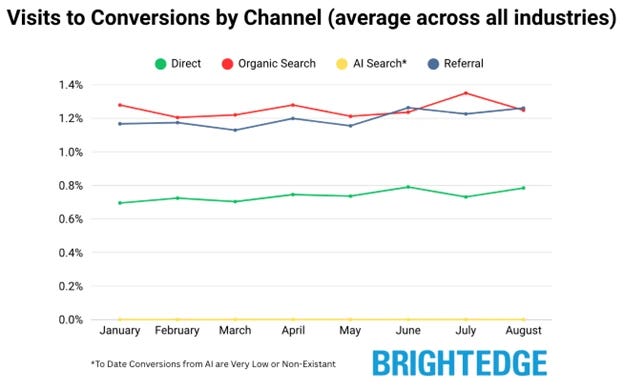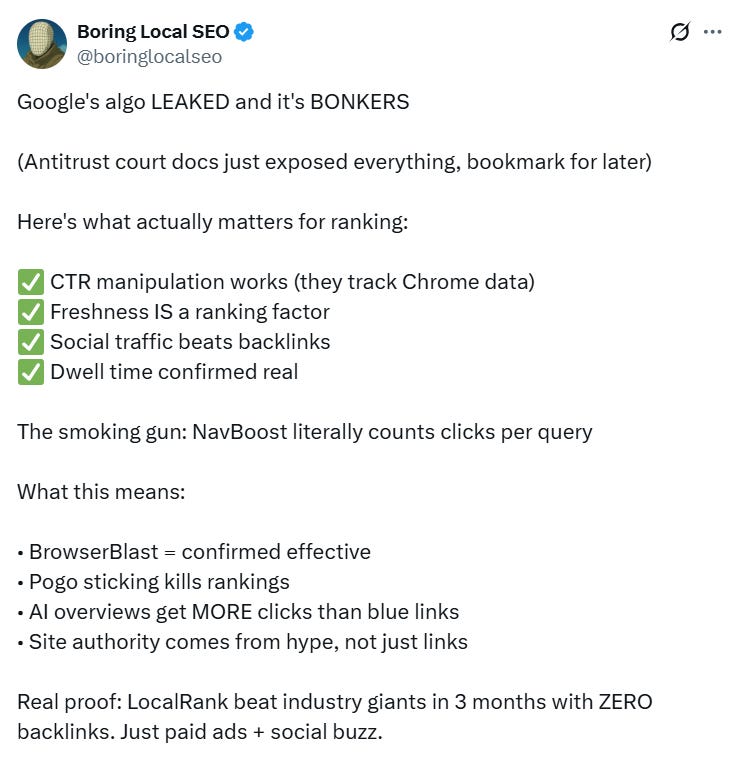Beat Fatigue with Scarcity
🔄 Retire, revive, and reframe products for frenzy, AI Search Growth vs. Google’s Ongoing Dominance, and more!
Howdy Readers 🥰
In this newsletter, you’ll find:
🔄 Beat Fatigue with Scarcity
🔎 AI Search Growth vs. Google’s Ongoing Dominance
🚀 Tweet of the Day
If you’re new to Buyology then a hearty welcome to you, You’ve reached the right place alongside 50k+ amazing people, Before you forget, if someone forwarded this newsletter to you, don't forget to subscribe to our newsletter so you never miss out!
🔄 Beat Fatigue with Scarcity
DTC brands don’t suffer from too few launches. They suffer from too many launches that blur into each other and decay fast. The problem isn’t product fatigue, it’s anticipation collapse.
This play flips seasonal fatigue into cyclical scarcity. You don’t need a new SKU. You need to reframe its return.
🎯 The Core Play: Forced Inactivity → Manufactured Frenzy
The Setup: Pull a SKU that’s plateaued. Let it vanish for 30–90 days. No fake “sold out.” Be clear: “Temporarily retired.”
The Return: Reintroduce the exact SKU, but pair it with a new access mechanic: email unlocks, SMS-only drops, micro-influencer waitlists, and early VIP gates.
The Result: The re-entry performs like a launch, even when the product hasn’t changed, because the calendar did.
This isn’t fake urgency. It’s engineered anticipation.
🌀 Why This Works Now: August–October is the BFCM Loading Zone
Between now and Black Friday, most brands either fire too early or wait too long. But BFCM warm-up isn’t just about discount timing, it’s about attention formatting. A reintroduced SKU in September sets up:
Creative refreshes without R&D
Pre-BFCM segmentation (buyers vs. watchers)
Scarcity energy you can drag into Q4
Every launch like this becomes a reset point for conversion psychology.
🔁 Conversion Event Stacking: Turn Scarcity Into List Growth
The real compounding happens when each SKU comeback is built as a growth loop:
Email-only waitlists capture re-interest before the re-drop.
Influencer flywheels leak access, creating social proof ahead of relaunch.
Tiered unlocks (e.g., SMS gets it 48 hrs earlier) drive channel opt-ins.
Suddenly, your dusty SKU isn’t just a product. It’s a list-building campaign.
📦 Real-World Fix: Scarcity Without Sloppiness
Execution breaks down post-checkout. You hype scarcity, and then ship a generic brown box 8 days late.
📉 That kills the experience loop.
Shipfusion analyzed 110 Cosmetic brands and found that 75% missed higher AOV with no post-purchase offers, and 33% had damaged items or zero interior branding.
Download the DTC Delivery Files and audit your post-drop experience before your next SKU revival. If you ship to customers, these insights are for you.
This reframes old product decay into calendar-driven anticipation. It plugs into BFCM timing, stacks audience growth, and syncs seamlessly with your existing creative workflows. This is how smart brands launch without launching, and make every comeback count.
🔎 AI Search Growth vs. Google’s Ongoing Dominance
AI search is expanding rapidly, but new data shows it’s still a tiny slice of the traffic pie while traditional organic search remains the heavyweight for referrals and conversions.
The Breakdown:
1. AI Search Traffic Remains Minimal - BrightEdge found that AI-driven search referrals accounted for less than 1% of total traffic from January to August, even with some platforms seeing triple-digit monthly growth. This means AI search currently drives little measurable sales or conversions despite all the hype.
2. Organic Search Still Powers Conversions - Organic search continues to be the primary driver of both traffic and conversions across industries, proving that it remains the most dependable channel for sustainable growth and customer acquisition.
3. ChatGPT Users Still Lean on Google - Similarweb data shows 95.3% of ChatGPT users also visit Google, while only 14.3% of Google users visit ChatGPT. Even as ChatGPT logged 5.8B visits vs. Google’s 83.8B, Google remains the first stop for nearly everyone searching online.
4. AI Search Growth Has Limit - Despite explosive interest, ChatGPT referral traffic is inconsistent and still dwarfed by Google. Search Engine Land, for example, reported 37x more referral traffic from Google than ChatGPT, highlighting AI tools as more of a research supplement than a replacement.
The data shows that conversions and consistent digital growth remain firmly tied to tried-and-true SEO, while AI search is best treated as a complement rather than a replacement. The smartest strategy is to adapt to AI’s rise while doubling down on the organic tactics that have always delivered measurable results.
🗝️ Tweet of the Day
Advertise with Us
Wanna put out your message in front of over 50,000 best marketers and decision makers?
Checkout our Partner Kit here🤝
At Buyology, we care about our readers and want to provide the best possible experience. That's why we always look for ways to improve our content and connect with our audience. It would be amazing if you could hit us up with feedback about our content or absolutely anything, we are always up for a chat 🥰
Thanks for your support, We'll be back with more such content 🥳


